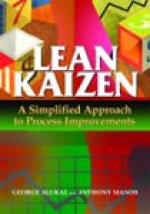Tab Article
To compete successfully in today’s economy, organizations need to be as good as or better than their global competitors. This goes not only for quality, but also for costs and cycle times (lead time, processing time, delivery time, set-up time, response time, etc.). Lean addresses these needs in its emphasis on teamwork, continuous training and learning, produce to demand (“pull”), mass customization and batch size reduction, cellular flow, quick changeover, and total productive maintenance.Originally applied in manufacturing settings, lean has now migrated to non-shop floor activities: in business support functions, such as sales, customer service, accounting, human resources, engineering, purchasing; within manufacturing firms; and also in purely service areas like finance, government, and healthcare.The intended audience for this book is any quality or operational professional who wants to start their lean journey or enhance their career opportunities. After introducing the concepts of lean and kaizen, various building blocks of a lean enterprise are described. After reading this book, any reader will have a foundation of what is understand today as "lean." All the examples of kaizens presented in the book are from the authors' experience associated with real lean transformations. In addition, the forms, figures, and checklists included as part of this book and also on the accompanying CD-ROM can be customized and used in the readers’ own lean journey when they perform kaizens.


